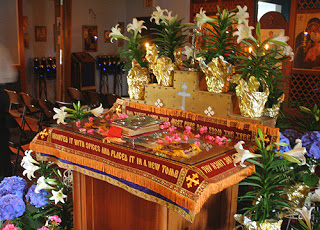 |
| A decorated “Tomb” for Holy and Great Friday |
On Friday night, the Matins of Holy and Great Saturday, a unique service known as the The Lamentation at the Tomb (Epitáphios Thrēnos) is celebrated. This service is also sometimes called Jerusalem Matins. Much of the service takes place around the tomb of Christ in the center of the nave. A unique feature of the service is the chanting of the Lamentations or Praises (Enkōmia), which consist of verses chanted by the clergy interspersed between the verses of Psalm 119 (which is, by far, the longest psalm in the Bible).At the end of the Great Doxology, while the Trisagion is sung, the epitaphios is taken in procession around the outside the church, and is then returned to the tomb. Some churches observe the practice of holding the epitaphios at the door, above waist level, so the faithful most bow down under it as they come back into the church, symbolizing their entering into the death and resurrection of Christ.The epitaphios itself represents the body of Jesus wrapped in a burial shroud, and is a roughly full-size cloth icon of the body of Christ. Then the priest may deliver a homily and everyone comes forward to venerate the epitaphios. In the Slavic practice, at the end of Vespers, Compline is immediately served, featuring a special Canon of the Crucifixion of our Lord and the Lamentation of the Most Holy Theotokos by Symeon the Logothete.
Before the service begins, a “tomb” is erected in the middle of the church building and is decorated with flowers. Also a special icon which is painted on cloth (in Greek, epitaphios; in Slavonic, plaschanitsa) depicting the dead Saviour is placed on the altar table. In English this icon is often called the winding-sheet.
The Matins of Holy Saturday are usually celebrated on Friday night. They begin in the normal way with the singing of God is the Lord, the troparion The Noble Joseph, and the following troparia:
When Thou didst descend to death 0 Life Immortal, Thou didst slay hell with the splendor of Thy Godhead! And when from the depths Thou didst raise the dead, all the powers of heaven cried out: O Giver of Life! Christ our God! Glory to Thee!
The angel standing by the grave cried out to the women: Myrrh is proper for the dead, but Christ has shown himself a stranger to corruption.
In place of the regular psalm reading the entire Psalm 119 is read with a verse praising the dead Saviour chanted between each of its lines. This particular psalm is the verbal icon of Jesus, the righteous man whose life is in the hands of God and who, therefore, cannot remain dead. The Praises, as the verses are called, glorify God as “the Resurrection and the Life,” and marvel at his humble condescension into death.There is in the person of Jesus Christ the perfect unification of the perfect love of man toward God and the perfect love of God toward man. It is this divine human love which is contemplated and praised over the tomb of the Savior. As the reading progresses the Praises become shorter, and gradually more concentrated on the final victory of the Lord, thus coming to their proper conclusion:
I long for Thy salvation, 0 Lord, Thy law is my delight (Ps 119:174).
The mind is affrighted at Thy dread and strange burial.
Let me live, that I may praise Thee, and let Thy ordinances help me (119:175).
The women with spices came early at dawn to anoint Thee.
I have gone astray like a lost sheep, seek Thy servant, for I do not forget Thy commandments (119:176).
By Thy resurrection grant peace to the Church and salvation to Thy people!
After the final glorification of the Trinity, the church building is lighted and the first announcement of the women coming to the tomb resounds through the congregation as the celebrant censes the entire church. Here for the first time comes the clear proclamation of the good news of salvation in Christ’s resurrection.
Source



my how one year goes by so quickly..its already time to try it again..and try,we will..